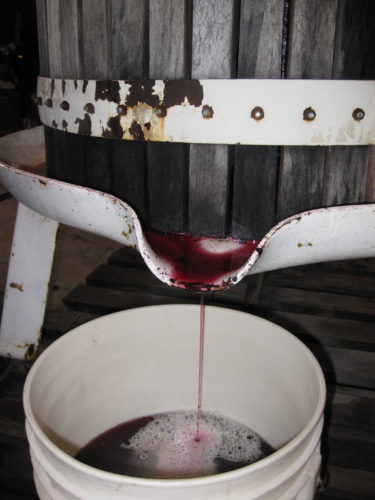2011 Five Rows Sauvignon Blanc:
The fight for quality Sauvignon Blanc grapes begins in earnest during the long, cold nights of winter. Its buds are amongst the most sensitive of all Vitis vinifera cultivars. Providing those buds make it through the rigours of winter and frosts of spring, the job only intensifies. Picture the most vigorous growing vine or weed in your garden, then imagine somehow trying to harness it’s raw desire to grow, but not so much to harm its delicate fruit. Now you’re talking Sauvignon Blanc!
Thanks to a cooler than normal spring, the 2011 growing season got off to a lazy start. A hot, dry summer helped put things back on track, with Sauv Blanc ripening right around schedule in late September. One vineyard trick we’ve employed in recent years is to remove leaves around the clusters early in the season on the cooler, “morning sun” (east-facing) side of the canopy only. Then later in the season, after veraison, we remove leaves from the “afternoon side” as the daytime heat subsides. This helps preserve flavour and acidity in the ripening berries and prevents sunscald.
750 kg of fruit was harvested from each of our two Sauvignon Blanc Vineyard blocks on September 22, 2011. The conditions for fruit ripening were perfect. Acid levels (TA) hovered around 7.5 to 8.0 g/L, but threatened to fall as warm conditions loomed later in the week. The decision to take both blocks in one day was made.
As usual, the younger clay-based block was slightly higher in sugar (22.3°Brix) than the old-vine, sandy loam block (20.6). I always find it difficult to describe just how intense the flavours are in these ripe Sauv Blanc berries. Best just to visit us in September and sneak a few for yourself!
Four older French oak barrels (2 x 2007 DAMY and 2 x 2003 Berthomieu) were used to ferment 75% of the juice. The rest was fermented in stainless steel. All fermentations were carried out with X5 yeast at an average temperature of 12°C. The fermentations were stopped at a specific gravity of 0.998 or, unscientifically, when I thought they tasted good. 99 cases were bottled on April 2, 2012.
Price: $25.00/bottle
Aromas: citrus (lemon/lime), grilled pineapple, gooseberry
Palate: lime, star fruit, great balance
2011 Five Rows Pinot Gris:
I relish the challenges involved in successfully crafting Pinot Gris each vintage. From thinning and leaf removal decisions to barrel/tank ratio and residual sugar content, the complex set of variables is alluring. Every choice made affects the end product and must be considered carefully. I’ve fallen asleep on countless nights labouring over such decisions. In the end, it only makes a winemaker appreciate the finished product that much more.
We harvested 1.5 tonnes of Pinot Gris on September 22, 2011. The fruit was adequately ripe (23°Brix) but starting to show signs of breaking down and rapidly losing acidity. You come to realize that Pinot Gris tells you when to harvest, you don’t tell it.
After gentle pressing and a four-day cold settle, the juice was racked to three older French oak barrels and one tank. It was then inoculated with R2 yeast at the normal rate of 300 ppm. The fermentation proceeded very slowly over the next month with an average temperature of 11°C, until being stopped at a specific gravity of 0.998 and total alcohol of 13.0%. Bentonite fining and coarse filtration were carried out before bottling 102 cases on April 2, 2012.
Visually, this Pinot Gris shows a distinct pinkish hue from the brief amount of skin contact. The striking aromatics include apple, pear torte, vanilla and tropical fruit nuances. The weighty yet velvety smooth texture resolves into flavours of ripe apple, melon, honey and cinnamon. It truly leaves you wanting another sip.
Production: 102 cases
Price: $25.00/bottle
Cellaring: 2012-2014
Serving: serve slightly chilled (10°C) and decant if consumed in 2012





